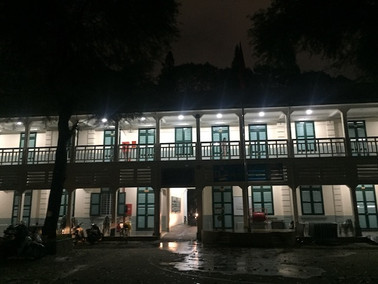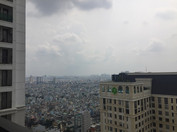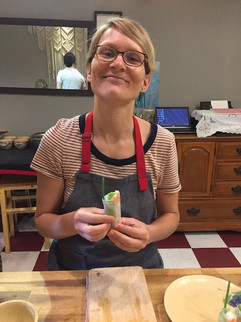November 5-9, and 17-19, 2019

Population: 8.4 million (8.8% total, most populous in Vietnam)
Financial center of Vietnam
From 1955 to 1975, Saigon was the capital of the Republic of Vietnam, commonly known as South Vietnam.
The city was renamed in 1976 after the Communist party leader but the name Saigon is still widely used.
The city was our urban coup-de-coeur ❤️ in Vietnam. We liked it so much that we extended our stay by 2 days and came back after the Mekong tour.
Beyond the family history pilgrimage, Ho Chi Minh City (HCMC) is an electric and vibrant city, with a mix of old and new. Let me show you.
Saigon was the cradle of the Monges (my paternal grand-father) for 3 generations, and we crafted an itinerary to follow in our ancestors' footsteps.
1. Family villa at 135 Pellerin st (now Pasteur st), has been razed a long time ago, replaced by a building. We went by night and the lot is now split up in 135 and 135A, both have buildings on them.
2. Saigon Sports Circle (Cercle Sportif Saïgonnais), now Ho Chi Minh City Labor Palace – where my grand-father and his little brother used to go swimming, playing tennis, meeting up with their friends, and even dancing on Sunday evenings, as teenagers. I attach a picture taken in the 40s and we could recognize the places during our visit. Ironically, there are still pétanque (bowls) grounds that are used today, a legacy from the French.
Swimming pool in the 1940s and in 2019
3. Lê Quý Đôn High School, formerly Lycée Chasseloup-Laubat where my grand-father, his brother and 2 sisters studied from primary school to high school. My grand-mother also taught Natural Sciences there. Public figures such as French writer Marguerite Duras and future King Norodom Sihanouk of Cambodia (who was in class with 1 of my grand-father’s sister) received education there as well.
High school in 1905 and now
4. Ho Chi Minh City Hall, where my grand-parents got married for the civil marriage (before heading to church). Modeled on the Paris’ City Hall, it gets spectacular when lighted up at night. From there, a pedestrian esplanade running to the Saigon river, is a great place to hang out without worrying too much about scooters. An imposing statue of Ho Chi Minh stands on it, as observing the heart of the city.

5. Notre-Dame, the cathedral where my grand-parents and great-grand-parents got married. All building materials were imported from France. The outside wall of the cathedral was built with bricks from Toulouse. Despite the on-going renovations, it has not lost its grandeur but we couldn’t go inside though.

From the French colonial era, there are even more historical buildings worth mentioning:
Central Post Office, built between 1886 and 1891 and designed by Marie-Alfred Foulhoux (though often credited to Gustave Eiffel). Painted on the walls of its grand concourse are fascinating historic maps of South Vietnam, Saigon and Cholon, while a mosaic of Ho Chi Minh takes pride of place at the end of its barrel-vaulted hall (Lonely Planet Vietnam).
Reunification Palace, built in 1868 for the French governor-general of Cochinchina and gradually expanded to become Norodom Palace. Became the residence of the President of South Vietnam in 1954. Bombed and badly damaged during an attempted coup in 1962, torn down and replaced by the present Independence Palace in 1975 not in use ever since.
Apparently, my grand-father, back from Kunming in September 1945, was part of the military parade leaving from Norodom palace to celebrate the troops return.

Saigon Opera House, built in 1897 by a French architect, the exterior was shaped like the Petit Palais in Paris, the interior accommodating 800 seats. Used as the home of the Lower House assembly of South Vietnam after 1956, it was not until 1975 that it was again used as a theatre, and restored in 1995.
Mong Bridge (Cầu Mống in Vietnamese, "Rainbow bridge") – close to Monges, isn’t it? – a pedestrian steel bridge connecting District 1 and District 4, is one of the oldest bridges in HCMC. Designed by Gustave Eiffel (yes he got a lot of work in Indochina), it was built in 1893-1894.
Our hotel was in District 4 and we were crossing the bridge every day, which was taking us to Pasteur Street.


Fine Art Museum, although we did not enter, we saw the
exterior of the building, very elegant and slender despite being a 3-storey house. It was designed by a French architect and built between 1929 and 1934.
After the French colonial era, Vietnam was at war for 30 years. We visited the Museum of war remnants on the 2nd Indochina war or US-Vietnam war.
For anyone interested in history, this museum is a must-see. Once called the museum of American and Chinese atrocities (renamed after the reconciliation with the US and the end of embargo in 1994), it gives another perspective on the conflict.
Bubble of History: Vietnam was part of Indochina and under French protectorate since 1860. During WWII, in 1941, as France was occupied by Germany and was under Vichy government, Japan took over and ruled Indochina until its surrender in August 1945.
At the end of WWII, the Vietnamese decided it was time for them to gain back their independence and declare the Republic of Vietnam in September 1945. That’s when the first Indochina war started as the French wanted to keep it under their control.
The 1st war was lost by France in 1954 and followed by the Geneva Conference, stating that Vietnam was split in 2: in the north the Democratic Republic of Vietnam ruled by Ho Chi Minh, in the south, the State of Vietnam - allied of the US (who had helped the French during the war and were fighting in Korea).
For obvious reasons, the North did not acknowledge the government of the South, a civil war started. The Vietnam War started shortly after, when the US got involved in support of the South.
The war lasted for more than 15 years and the last US troops left in 1975.
The museum is very well done and the exhibitions are laid out in a great way.
Outside the main building, many US airplanes, helicopters, tanks and weapons are exhibited, probably to show the level of equipment that the Vietnamese were dealing with.
On the second floor, the chronology of the conflict is recreated. Another room is dedicated to photographies of the conflict, taken by US, European and Asian photographers, showing the harsh reality of the soldiers and the Vietnamese people. One of the most famous photograph "The napalm girl" (by Nick Ut, who won the Pulitzer Prize) is shown there.
One of the most infamous massacres is explained there : the My Lai village one in 1968. That event was a turning point in the history of that war. Many soldiers realized something was going wrong and opened up to the press allowing the public to understand the situation.
That room also pays a tribute to all war reporters and photographers who risk their lives (many of them were wounded or killed) to show the world the reality of a conflict.
Then, maybe one of the hardest exhibition we have ever seen (the girls were waiting outside) was the Orange Agent room which shows the effect of this chemical weapon used in the Vietnam war. Not only was this devastating and killed many but it had a lasting impact on the people who got in contact with it: cancers, leukemias, genetic diseases and deformities on offspring. That, of course, affected the Vietnamese but also US soldiers and their families long time after the war ended.
FYI, among the companies that provided the orange agent, one could see familiar names such as Monsanto or Dow Chemicals. No comment…
Exiting the room, 4-5 people affected by orange agent, employed by the museum, were building and selling crafts. It was very disturbing and the girls, with us at that point, asked a lot of questions.
Finally, one last room shows the anti-war movement in the US (people, artists but also politicians, soldiers and veterans). It really started in 1968 as people were realizing the US was getting bogged down in the war.
Although the exhibition is probably a one-sided view of the conflict, omitting many anti-US actions from the communist government, it gives another point of view on the conflict and is very well documented, encompassing US and European sources.
Usually, 1 picture is worth 1,000 words. In that museum, pictures were so impactful that it left us speechless. But we highly recommend whoever is in Saigon to visit it.
After the war, Vietnam was on embargo until 1994, when the country came back on the international scene. The GDP started to increase, bringing an inflow of money into the country thanks to international partnerships. Saigon welcomes the highest number of expats in Vietnam.
HCMC is a city of contrasts - modern buildings blending in falling down neighborhoods, brand new sports cars mixing with old dirty motorcycles, fancy restaurants (or international) sitting next to street food carts.
Actually, Vietnam might have had a speculative construction frenzy. Construction of the metro has started in 2012 across the city. After multiple delays, it is now supposed to start operating in 2021. It will consist into 9 lines, subway, tramway and light rail. I am not super optimistic on the 2021 deadline, because the big construction site near Ben Thanh market looked desert and we never saw the huge crane moving although we passed by several times in the area.
We also saw a lot of abandoned construction sites scattered in the city, with faded renderings of the initial project giving an idea of what it could have been (see picture). Seems like a waste of space in such a densely populated city.
Construction of Ben Thanh Metro and sky scraper rendering
Let us share nice places we liked hanging out in

Book street, near the Post Office – 15 to 20 bookstores are lined up on that street inaugurated in 2016. We could find English books for Naema and donated some of the French books she was done reading.
Ben Thanh market, developed from informal markets created by early 17th century street vendors gathering near the Saigon River. The market was formally established by the French colonial powers. Was destroyed by fire in 1870 and rebuilt to become Saigon's largest market.
November 8 was Salah’s birthday so we took advantage of being in such a nice and lively city to celebrate in many ways.
On November 6, he got his birthday gift : a cooking class (with the whole family). Vietnam cuisine is so great and Salah loves cooking, it would have been a shame to miss the opportunity. We took the class together and the group class turned out to be a private class because we were the only ones signed up.
We met our teacher, Chef My, at Ben Thanh market and started off buying fresh product for the class. She showed us the best spots to buy veggies, different kind of herbs, fish sauce, fresh coconut milk, etc. Many products are new or unknown to us in South-East Asia, so that was the occasion to ask Chef My all the questions we had since we started our trip.
Then we took a cab to her cooking local. We cooked three dishes : fresh spring rolls with pork and shrimp, banana blossom salad and banh xeo (Vietnamese crepe). We had a lot of fun on the class and the food was delicious. Naema was fully part of the class, Lana was able to try many things with the help of Chef My. The girls loved it and were doing a pretty good job. And we had a very good lunch!
Pasteur Brewing Co., a local brewery with quality beers, serving burgers, mac’n’cheese. This is where we celebrated Salah’s birthday. The vegetarian burger was served with bbq jackfruit, a bit mushy but tasty.
Marou – Coralie's favorite place – the chocolaterie that we first saw in Hanoi. We came back, found out they were serving made-to-order pastries that looked amazing so we could not resist. And we went back for Salah’s birthday!
We had a great time in Saigon. Loved the city, the visits, the large avenues, the food. Also loved the rental apartments we had, in newer buildings most likely targeting expats. We took advantage of the pool (and watched beautiful sunsets), the kids’ playground and the gym. Staying in apartments allowed us (Salah 😉) to do some cooking, which we enjoyed. We had a market 5 minutes away from home to buy fruit and baguette for our breakfast. It was fantastic!
Swimming pool and gym (Lana fell in the pool right after this picture was taken)
Coralie's note: It felt very special to connect with my family 75 years later and share this with the girls. I was extremely grateful to have Christian, my grand-dad’s little brother, sharing memories and anecdotes via WhatsApp during the course of the trip. In a few years, I will be able to tell our story to the girls again and refresh their memory, with travel narrative and pictures, on where they are coming from.
Thanks for reading all the way through!😃
Coralie & Salah












































































































































Comments